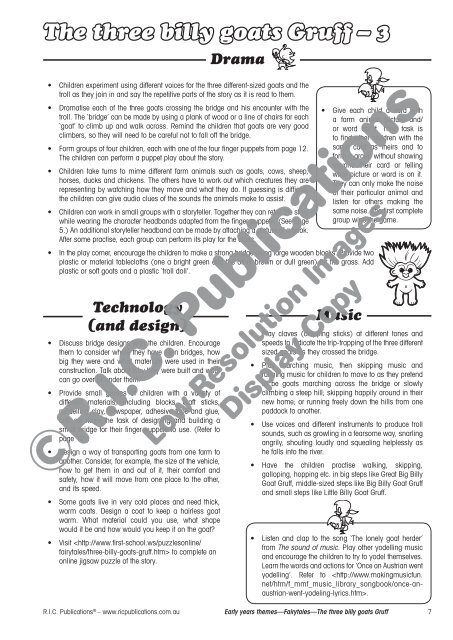RIC-20935 Early years Fairytales - Billy goats
Create successful ePaper yourself
Turn your PDF publications into a flip-book with our unique Google optimized e-Paper software.
The three billy <strong>goats</strong> Gruff – 3<br />
Drama<br />
• Children experiment using different voices for the three different-sized <strong>goats</strong> and the<br />
troll as they join in and say the repetitive parts of the story as it is read to them.<br />
• Dramatise each of the three <strong>goats</strong> crossing the bridge and his encounter with the<br />
troll. The ‘bridge’ can be made by using a plank of wood or a line of chairs for each<br />
‘goat’ to climb up and walk across. Remind the children that <strong>goats</strong> are very good<br />
climbers, so they will need to be careful not to fall off the bridge.<br />
• Form groups of four children, each with one of the four finger puppets from page 12.<br />
The children can perform a puppet play about the story.<br />
• Children take turns to mime different farm animals such as <strong>goats</strong>, cows, sheep,<br />
horses, ducks and chickens. The others have to work out which creatures they are<br />
representing by watching how they move and what they do. If guessing is difficult,<br />
the children can give audio clues of the sounds the animals make to assist.<br />
• Children can work in small groups with a storyteller. Together they can retell the story<br />
while wearing the character headbands adapted from the finger puppets. (See page<br />
5.) An additional storyteller headband can be made by attaching a picture of a book.<br />
After some practise, each group can perform its play for the class.<br />
• Give each child a card with<br />
a farm animal picture and/<br />
or word on it. Their task is<br />
to find other children with the<br />
same card as theirs and to<br />
form a group without showing<br />
anyone their card or telling<br />
what picture or word is on it.<br />
They can only make the noise<br />
of their particular animal and<br />
listen for others making the<br />
same noise. The first complete<br />
group wins the game.<br />
• In the play corner, encourage the children to make a strong bridge using large wooden blocks. Provide two<br />
plastic or material tablecloths (one a bright green and the other brown or dull green) for the grass. Add<br />
plastic or soft <strong>goats</strong> and a plastic ‘troll doll’.<br />
Technology<br />
(and design)<br />
• Discuss bridge designs with the children. Encourage<br />
them to consider where they have seen bridges, how<br />
big they were and what materials were used in their<br />
construction. Talk about why they were built and what<br />
can go over or under them.<br />
• Provide small groups of children with a variety of<br />
different materials, including blocks, craft sticks,<br />
modelling clay, newspaper, adhesive tape and glue,<br />
and set them the task of designing and building a<br />
small bridge for their finger puppets to use. (Refer to<br />
page 12.)<br />
• Design a way of transporting <strong>goats</strong> from one farm to<br />
another. Consider, for example, the size of the vehicle,<br />
how to get them in and out of it, their comfort and<br />
safety, how it will move from one place to the other,<br />
and its speed.<br />
• Some <strong>goats</strong> live in very cold places and need thick,<br />
warm coats. Design a coat to keep a hairless goat<br />
warm. What material could you use, what shape<br />
would it be and how would you keep it on the goat?<br />
• Visit to complete an<br />
online jigsaw puzzle of the story.<br />
Music<br />
• Play claves (clapping sticks) at different tones and<br />
speeds to indicate the trip-trapping of the three different<br />
sized <strong>goats</strong> as they crossed the bridge.<br />
• Play marching music, then skipping music and<br />
running music for children to move to as they pretend<br />
to be <strong>goats</strong> marching across the bridge or slowly<br />
climbing a steep hill; skipping happily around in their<br />
new home; or running freely down the hills from one<br />
paddock to another.<br />
• Use voices and different instruments to produce troll<br />
sounds, such as growling in a fearsome way, snarling<br />
angrily, shouting loudly and squealing helplessly as<br />
he falls into the river.<br />
• Have the children practise walking, skipping,<br />
galloping, hopping etc. in big steps like Great Big <strong>Billy</strong><br />
Goat Gruff, middle-sized steps like Big <strong>Billy</strong> Goat Gruff<br />
and small steps like Little <strong>Billy</strong> Goat Gruff.<br />
• Listen and clap to the song ‘The lonely goat herder’<br />
from The sound of music. Play other yodelling music<br />
and encourage the children to try to yodel themselves.<br />
Learn the words and actions for ‘Once an Austrian went<br />
yodelling’. Refer to .<br />
R.I.C. Publications ® – www.ricpublications.com.au <strong>Early</strong> <strong>years</strong> themes—<strong>Fairytales</strong>—The three billy <strong>goats</strong> Gruff 7


















